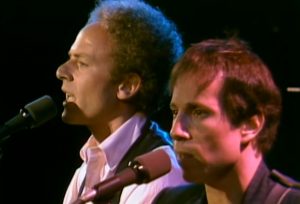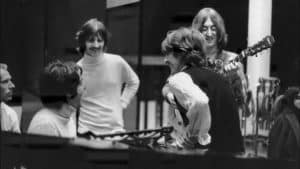10 Single Bad Songs From Great Classic Rock Albums

via HDPinkFloyd / YouTube
Not every classic rock album is perfect from front to back, no matter how much fans might insist otherwise. Tucked between the hits and deep cuts are occasional head-scratchers—songs that disrupt the flow, derail the mood, or just fall flat compared to the greatness surrounding them. It doesn’t mean the albums themselves aren’t brilliant, but it does remind us that even the best artists can take a wrong turn.
Sometimes it’s a misguided experiment, other times it’s a track that feels phoned in or painfully out of place. Maybe it’s the awkward lyrics, an uncharacteristic genre detour, or just a tune that overstays its welcome. Whatever the reason, these tracks stand out—but not in a good way.
This list dives into those rare misfires: the one song on an otherwise fantastic album that makes you question how it ever made the cut. They’re not necessarily the worst songs ever written—but when stacked against their legendary company, they can’t help but sound like a blemish on brilliance.
10. “Mother”, The Police (Synchronicity, 1983)
When The Police released Synchronicity, it was packed with some of their biggest hits, but “Mother” stuck out for all the wrong reasons—at first. The frantic vocals and chaotic energy of the track felt more like an unhinged experiment than a song meant for radio. Andy Summers takes the spotlight, howling lines that made even loyal fans scratch their heads.
Over time, however, “Mother” began gaining recognition—not for musical brilliance, but for its sheer weirdness. In the internet age, the track became meme-worthy, drawing attention from younger audiences who appreciated its eccentricity. TikTok and YouTube remixes even gave it a new cult status among fans of unconventional deep cuts.
Today, while it’s not considered essential listening, “Mother” holds a strange place in pop culture. People rediscovered it as part of the Synchronicity experience, often discussing it with amusement or curiosity. It went from being the track everyone skipped to the one they now laugh about—and occasionally play again just to feel the chaos.
9. “The Crunge”, Led Zeppelin (Houses of the Holy, 1973)
Led Zeppelin’s Houses of the Holy was a daring leap from their earlier records, exploring funk, reggae, and experimental grooves. “The Crunge” was their most polarizing attempt—part homage, part parody of James Brown-style funk. While it showed the band’s versatility, it never quite clicked with many fans used to their hard rock roots.
Initially dismissed as filler or a misstep, “The Crunge” has slowly earned appreciation for its groove and humor. Listeners who revisit the album now hear the playfulness in Plant’s vocals and the band’s chemistry, even if the track still feels out of place next to powerhouses like “No Quarter.” It’s not typical Zeppelin, but it’s not trying to be.
In recent years, music historians and funk fans have highlighted the track for its boldness and musicianship. It’s no longer the song that gets skipped automatically—it’s the weird little detour that gets a second listen, especially from those curious about the band’s creative range.
8. “Something 2 Dance 2”, N.W.A. (Straight Outta Compton, 1989)
Straight Outta Compton redefined hip-hop, but its closing track, “Something 2 Dance 2,” threw listeners for a loop. Unlike the gritty, unflinching storytelling of the rest of the album, this upbeat dance cut felt like it belonged to a different group entirely. It was the contribution of Arabian Prince, aiming for a lighter club vibe that didn’t quite match the rest.
At the time, it was jarring—critics and fans alike questioned its placement. Yet decades later, the song found new life as a retro dance curiosity. DJs began mixing it into old-school hip-hop sets, and fans exploring the group’s full catalog gave it a chance without the shadow of the heavier tracks before it.
It’s still divisive, but “Something 2 Dance 2” is now viewed with more appreciation. Its funky beat and synth work feel like a snapshot of the late 80s club scene, offering a lighthearted contrast to the album’s otherwise intense legacy. It’s not a banger—but it’s got charm.
7. “Seaside Rendezvous”, Queen (A Night at the Opera, 1975)
Queen’s A Night at the Opera is celebrated as one of the most ambitious rock albums of the 1970s, but “Seaside Rendezvous” was always a curious detour. With its vaudeville flair and old-timey sound effects, it felt more like a novelty than a serious track. For many fans, it was charming but skippable.
Still, Queen was never afraid to lean into theatricality, and “Seaside Rendezvous” is a prime example. Over the years, listeners have grown to admire its clever arrangement and playfulness. Freddie Mercury’s vocal gymnastics and the band’s DIY sound effects are now seen as proof of their boundless creativity.
Thanks to live tributes and internet nostalgia, the song has found a quirky afterlife. It’s popped up in fan edits, commercials, and themed playlists, endearing itself to a new generation of Queen listeners who love its offbeat charm. Once overlooked, it now shines as a gleeful oddball in the band’s vast catalog.
6. “The Overload”, Talking Heads (Remain in Light, 1980)
Talking Heads’ Remain in Light pushed boundaries in every direction, but “The Overload” brought the album to a brooding halt. The song’s dark ambiance and slow tempo clashed with the upbeat energy that defined much of the record. Inspired by Joy Division (a band they hadn’t even heard at the time), it felt more like a concept than a crowd-pleaser.
At first, it was easy to forget. The song’s moody minimalism lacked the immediacy of “Once in a Lifetime” or “Crosseyed and Painless.” But fans looking for deeper, more introspective tracks began to gravitate toward it. Its haunting soundscape and eerie calm found a niche in lo-fi playlists and cinematic montages.
Now “The Overload” is often praised for its atmosphere and bold contrast to the rest of the album. It’s been sampled, covered, and referenced in indie circles, proving that even the quietest tracks can echo the loudest over time.
5. “All by Myself”, Green Day (Dookie, 1994)
Tucked at the very end of Dookie, after the fade-out of “F.O.D.,” lies a hidden track that most casual listeners don’t even know exists. “All by Myself” is a short, acoustic oddity written and performed by drummer Tré Cool. It’s silly, awkward, and clearly meant to be a joke—but it’s also the weirdest way to cap off an otherwise explosive pop-punk record.
Originally viewed as throwaway comedy, the song has somehow developed a following among Green Day fans. Maybe it’s the lo-fi charm or the sheer absurdity of the lyrics. In the streaming era, where even hidden tracks are indexed, “All by Myself” found itself resurfacing in playlists, reaction videos, and meme posts, giving it a strange kind of second life.
Though many still hit skip, the song has gained ironic appreciation. It’s quoted, shared, and sometimes celebrated just for how bizarre and off-brand it is. In an album known for angst, rebellion, and catchy choruses, “All by Myself” stands out as the strange, lonely laugh at the very end—and somehow, that’s exactly why people remember it.
4. “Jamaica Jerk-Off”, Elton John (Goodbye Yellow Brick Road, 1973)
Goodbye Yellow Brick Road is widely considered one of Elton John’s greatest achievements, but “Jamaica Jerk-Off” has long puzzled listeners. Its playful Caribbean rhythm and offbeat lyrics feel like a pastiche that didn’t quite land. With questionable vocals and a title that raises eyebrows, it’s long been one of the album’s most skipped tracks.
Over time, though, fans started embracing it—not necessarily as a masterpiece, but as a fun, guilty-pleasure oddball. Its awkward charm and bouncy beat have helped it carve out a nostalgic niche. In fact, it’s now sometimes included in Elton-themed parties or playlists as the song everyone loves to jokingly sing along to.
It may never rank among his best, but “Jamaica Jerk-Off” has survived the cringe and come back around as a kitschy gem. The internet’s taste for eccentric deep cuts has helped the song rebound in unexpected ways, giving it a legacy even its harshest critics didn’t see coming.
3. “Endless, Nameless”, Nirvana (Nevermind, 1991)
Nirvana’s Nevermind was a sonic revolution, but many were caught off guard by the chaotic hidden track “Endless, Nameless.” Appearing minutes after the serene closer “Something in the Way,” the song erupts like a musical tantrum—loud, noisy, and almost entirely without structure. At the time, it was easy to see it as a jarring misfire.
Yet for fans of Nirvana’s raw side, the track became a cult favorite. As interest in the band’s more abrasive material grew—especially with In Utero and various bootlegs—“Endless, Nameless” found new appreciation. People began to see it less as a mistake and more as a window into Cobain’s cathartic rage and artistic edge.
Now, it’s often cited as an essential deep cut for those who want the full Nirvana experience. Its legacy has shifted from confusing bonus noise to an emblem of the band’s grunge ethos—unfiltered, loud, and confrontational. It’s not for everyone, but that’s exactly why it endures.
2. “Maxwell’s Silver Hammer”, The Beatles (Abbey Road, 1969)
The Beatles’ Abbey Road is a monumental album, but “Maxwell’s Silver Hammer” has always stood apart—for better or worse. Paul McCartney’s storybook song about a cheerful murderer struck many as tonally bizarre. Complete with clanging anvil sounds and vaudeville melodies, it felt like a detour from the album’s otherwise polished genius.
Initially dismissed as a whimsical indulgence, the song has since been reappraised through a modern lens. Fans now find a dark comedy in its cheerful murder ballad tone. Its theatrical quality even inspired stage performances and parodies, showing that “Maxwell” had more staying power than anyone expected.
Though still polarizing, the song has clawed its way into Beatles lore, with listeners appreciating its eccentricity rather than deriding it. It’s one of those tunes people now share for its sheer strangeness—and its unexpected bounce back from obscurity proves just how deep the Beatles’ catalog really goes.
1. “Oh Daddy”, Fleetwood Mac (Rumours, 1977)
Fleetwood Mac’s Rumours is nearly flawless, but “Oh Daddy” often felt like the one lull in an otherwise gripping emotional rollercoaster. Christine McVie’s mournful ballad about Mick Fleetwood lacks the emotional bite or melodic punch of other classics on the album. For years, it was overlooked as the quietest, least memorable track in the lineup.
Still, time has softened perceptions. Fans have come to appreciate its subtlety and space, especially in contrast to the emotional fireworks of “Go Your Own Way” or “Dreams.” The haunting atmosphere and restrained vocals give “Oh Daddy” a timeless melancholy that now resonates more deeply with mature listeners.
In live performances and retrospectives, the song has found a new spotlight. It may never be the most famous track on Rumours, but its reemergence shows how even the softest moments can echo across decades. Quietly but surely, “Oh Daddy” made its way back into the conversation.





















